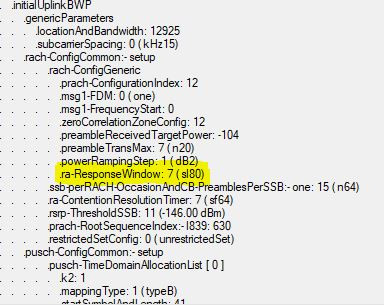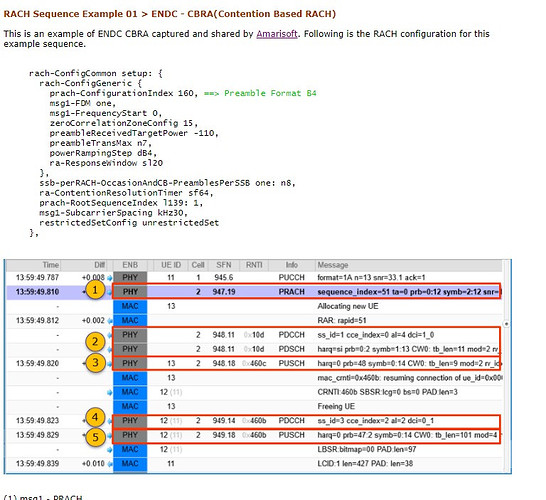That’s means it can be set Max 80 ms as per subcarrier spacing which in rach would be 15 KHz.
That’s strange.

Yes, it means NR gives lot of time for RACH response.
It may have some logic behind it.
May be to give chance for SSB threshold.
And in your case I see -146 dBm given.
-146 is rsrp-threshold SSB.
UE is forced to select a beam that is higher than this value.
Otherwise it will select any beam.
But this is so poor coverage threshold.
Is it to avoid beam failures?
It’s not poor coverage.
UE will get an SSB higher than this for sure (think at B1 threshold).
Minus 146 is still high I got that it will select higher value than minus 146.
Like minus 145 and so on for SSB selection.
Nope because B1 threshold is like -110.
So it will not degreade from -110 to -145 in a msec.
Yes that’s also right I got you @RFSpecialist, thanks dear.
Normally most prefer B1 as minus 106
But NR coverage would be less than LTE so setting minus 110 or below that would be good to latch in NR.
What is msg1 scs here?
I guess it would be 120 KHz.
Slot80 confines in 10ms.
Raresponse window should not be so high like 80ms.
No it is 15 KHz in RACH.
NR has flexible subcarrier.
And RACH consumes less SCS as not required.
You can see in that snap too.
RACH does not require huge packets.
So why waste on it? 
Yes, I saw the snap… but is it for RACH?
I don’t think so.
There is separate parameter msg1-SubcarrierSpacing which is SCS for RACH.
Can’t find the msg1-SubcarrierSpacing in the log.
And I think it can be either 15 KHz or 30 KHz.
Not possible to be 120 KHz.
Let me tell you whole story to understand what we are trying to figure out. 
Last month we trial 5G new feature to change RACH format from B4 to Format 0.
After this feature activation Msg1 success rate was degraded about 6 %.
We did analysis and found it’s because of Msg2 Disc failures increase after format 0.
Msg2 disc step up when gNB couldn’t process the initial preamble request within RACH window time.
But last week magic happen?
We roll out 5G another new feature called CSI-RS shifting.
This feature will help to change the position of CSI- RS to avoid CSI-RS collision.
I am sure many pepole aware about this feature.
But magic is that all Rach Msg2 failure reduce and back to normal position like before with Format B4.
Which increase after format 0.
Now questions is how CSI-RS shifting can reduce Msg2 failure?
msg1- SubcarrierSpacing only applies if you use short preamble format, since the RACH Subcarrier spacing can be either 15 or 30 KHz for FR1.
In case of long preamble format, the SCS is fixed since it can be only be used by FR1.
Short Preamble can be used by both FR1 and FR2.
Maybe you don’t know the whole story behind the “activating feature of csi-rs shifting”. Many times this activity is in reality a cumulative number of patches that correct many issues that MNOs are sometimes not even aware of. You better search inside logs what exactly was done at that time/night when csi-rs shifting was deployed. RACH format 0 does not accommodate well large cell radius, better use RACH format 1. I didn’t understood quite well your phrase: “Msg2 Disc failures increase after format 0”; does the gNodeB discard them ? Because gNodeB should send msg2, not discard msg2 so you better find what is the reason gNodeB discards Msg2. Anyway, I find little connection between csi-rs shifting feature and your rach problem. But would be good if somebody has a better understanding.
In mmWave with 120KHz SCS, doesn’t this PRACH become a limiting factor for coverage?
In FWA scenario where we expect 3 or 4 KM coverage, PRACH hurts the coverage. Extended range PRACH format C2 allows 1.2 KM. How significant is this limit? How to overcome this?
